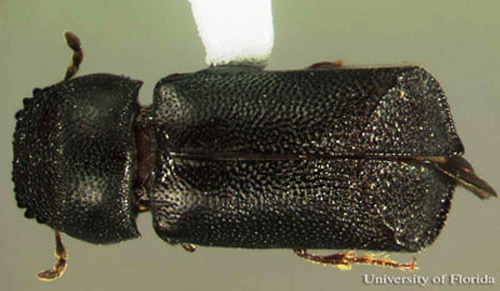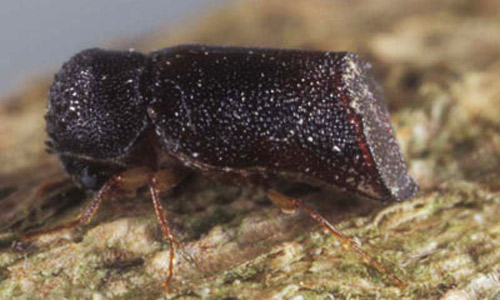common name: a false powderpost beetle
scientific name: Xylopsocus capucinus (Fabricius) (Insecta: Coleoptera: Bostrichidae)
Introduction - Distribution - Description - Biology - Hosts - Management - Selected References
Introduction (Back to Top)
Xylopsocus capucinus (Fabricius) has previously been intercepted at ports of entry into the U.S. on many occasions in a wide variety of plant materials. However, Fisher (1950) stated that it "...has not become established in the United States." On 14 March 1978, specimens were collected from cassava branches at Homestead, Florida, by J. Peña, and subsequent surveys indicate that the species is definitely established as a part of the Florida fauna.
Figure 1. Dorsal view of adult Xylopsocus capucinus (Fabricius), a false powder-post beetle. Photograph by Lyle J. Buss, University of Florida.
Distribution (Back to Top)
Occurs throughout most of the tropical areas of the world. Lesne (1901:633) listed it from the Indomalayan area to the Madagascaran region with specific locations as follows: Madagascar, Comores, Seychelles, Reunion, Mauritius, Sikkim, Coromandel, Nilghiri, Sri Lanka, Myanmar, Vietnam, Laos, Cambodia, Nicobar, Sumatra, Java, Sumbawa, Borneo, Celebes, Philippines, Ternate, Batjan, Ceram, Amboine, Kei, Arou, New Guinea, Trobriand, Woodlark, d'Entrecasteaux, Louisiade, New Hebrides, Espiritu-Santo, New Caledonia, Sierra Leone, South America (Guiana and eastern Brazil).
Fisher (1950:141) listed the following records: India, Ceylon, China, Thailand, Indochina, Myanmar, Taiwan, Philippines, nearly all Malaysian and Melanesian Islands, and Madagascar. He listed it as introduced into the eastern and western coasts of Africa, Guiana, Venezuela, Trinidad, and Brazil.
In Florida, it is presently known only from the area around Homestead (Dade County).
Description (Back to Top)
Adult: The adult ranges in length from 3 to 5.5 mm; and in width from 1.4 to 1.7 mm. The shape is cylindrical and similar in general appearance to other common species of the family Bostrichidae found in Florida. Because of this similarity, field identification is impractical, and specimens should be submitted to taxonomists for identification.
Figure 2. Lateral view of adult Xylopsocus capucinus (Fabricius), a false powder-post beetle. The vertical line represents 2 mm. Graphic by Division of Plant Industry.
The body color is black or reddish (particularly the elytra, venter, antennae, and palpi). The apical elytral declivity (sloping) is abruptly, obliquely deflexed, flattened, without tubercles or callosities (swollen lumps). The lateral margins of the declivity are strongly elevated, crenulate (margin notched with small rounded teeth) toward top, and completely enclose the declivity. This arrangement is distinctive from other U.S. Bostrichidae.
Figure 3. Lateral view of adult Xylopsocus capucinus (Fabricius), a false powder-post beetle. Photograph by Lyle J. Buss, University of Florida.
The larva has been described and illustrated by Gardner (1933).
Biology (Back to Top)
Beeson and Bhatia (1937) indicated that it was not common in India, but it emerged mainly between May and November without marked peaks of abundance. The life cycle there is apparently annual but may extend to two years, with stragglers in the third year. Additional biological data were given by Miller (1934), who stated that the life cycle is eight weeks when the larva feeds in Derris roots. He also recorded a reduviid bug (Peregrinator biannulipes Montr. & Sign.) as a predator on Xylopsocus capucinus.
Most damage appears to be caused to lumber or to plants already damaged by lightning, cold, or other insect injury. Kalshoven (1963b) listed it from piles of teak poles where the sapwood layer became honeycombed throughout. Most references mention dry branches and stems being most often infested. Marin Acosta (1975) listed it in unhealthy avocado trees and in stems of grape where its presence was shown by little masses of gum (in rolled strips) in their openings.
Hosts (Back to Top)
According to Fisher (1950), Lesne (1924) recorded this species living in the wood of Morus alba L. and in trunks of "Kimoungoue" in east Africa, in bamboo, litchi (Litchi chinensis Sonn.), and in grape (Vitis sp.) in Brazil. Miller (1934) recorded it attacking piquia (Caryocar villosum Pers.), rambutun (Nephelium lappaceum L.), rubber (Hevea brasiliensis (Willd. ex A. Juss) Muell. Arg.), Dipterocarpus sp., Derris sp., guava (Psidium guajava L.), Casuarina equisetifolia J.R. Forst. & G. Forst., Syzygium malaccensis (L.) Merrill & L.M. Perry, cinnamon (Cinnamomum zeylanicum Blume), Indigofera anil L., cashew nut (Anacardium occidentale L.), durian (Durio zibethinus J. Murr.), Tephrosia candida DC., Gardenia jasminoides Ellis, tamarind (Tamarindus indica L.), Hibiscus rosa-sinensis L., and mango (Mangifera indica L.).
Beeson and Bhatia (1937) reported it as also attacking Artocarpus hirsutus Lam., Ficus sp., Mallotus philippiensis Muell. Arg., Delonix elata (L.) Gamble, Santalum album L., Shorea robusta Gaertn.f., Sindora wallichii Benth., Swietenia mahagoni (L.) Jacq., Tectona grandis L.f., Terminalia myriocarpa Heurck & Muell. Arg., and Vitex negunto L. Guagliumi (1967) recorded it in avocado seed and stems and branches of cotopriz (Talisia oliviformis Radlk.).
The Florida host has only been cassava, in dry branches (presumably cold killed).
Management (Back to Top)
As presently known, the species does not appear to be a serious economic pest. Infested cassava branches were destroyed by burning.
Selected References (Back to Top)
- Anonymous. 1978. A bostrichid beetle (Xylopsocus capucinus (Fabricius)). Cooperative Plant Pest Report 3: 177.
- Beeson CFC, Bhatia BM. 1937. On the biology of the Bostrychidae (Coleoptera). Indian Forest Record 2: 223-320.
- Blackwelder RE. 1945. Checklist of the coleopterous insects of Mexico, Central America, the West Indies, and South America. U.S. Natural History Museum Bulletin 185, Part 3: 400.
- d'Araujo e Silva AG, Gonçalves CR, Galvao DM, Gonçalves AJL, Gomes J, Silva M do N, de Simoni L. 1968. Quarto catalogo dos insectos que vivem nas plantas do Brasil seus parasites e predadores. Pt. 2. Vol. 1: xiv + 622 p.
- Fabricius JC. 1781. Species Insectorum. 1: 1-552; Kilonii (Apate capucinus p. 62).
- Fisher WS. 1950. A revision of the North American species of beetles belonging to the family Bostrichidae. Miscellaneous Publications 698: 1-157 (Xylopsocus capucinus p. 140-141).
- Gardner JCM. 1933. Immature stages of Indian Coleoptera (13) (Bostrychidae). Indian Forest Research, Entomology Service 18: 1-19.
- Guagliumi P. 1966 [1967]. Insetti e arachnidi delle piante comuni del Venezuela segnalati nel periodo 1938-1963. Relazioni e monographie agrarie subtropicale e tropicali (n.s.) 68: i-xix, 1-391.
- Kalshoven LGE. 1963a. Ecological data on some Neotropical Scolytidae, Platypodidae, and Bostrychidae (Coleoptera) mainly of Surinam. Beaufortia 9: 232-240.
- Kalshoven LGE. 1963b. Notes on the biology of Indonesian Bostrychidae (Coleoptera). Entomologische Berichten (Amsterdam) 23: 242-257.
- Kingsolver JM. 1971. A key to the genera and species of Bostrichidae commonly intercepted in USDA plant quarantine inspections. Agricultural Quarantine Inspection Memo (USDA) 697: 1-11.
- Lesne P. 1900 [1901]. Revision des Coleopteres de la famille des Bostrychides. 4th Mem. Annales de la Societe Entomologique de France 69: 473-639.
- Marin Acosta JC. 1975. Plagas de insectos en algunos frutales de importancia economica en Venezuela. Bol. Techn. (Publ. Fondo de Desarrollo Fruticola) 3: 1-73.
- Miller NCE. 1934. Coleopterous pests of stored Derris in Malaya. Department of Agriculture Straits Settlements Federated Malay States, Scientific Series 14: 1-34.
- Spilman TJ. 1971. Bredin-Archbold-Smithsonian biological survey of Dominica: Bostrichidae, Inopeplidae, Lagriidae, Lyctidae, Lymexylonidae, Melandryidae, Monommidae, Rhipiceridae, and Rhipiphoridae (Coleoptera). Smithsonian Contr. Zoology 70: 1-10.
- Stebbing EP. 1914. Indian Forest Insects of Economic Importance. Coleoptera. London, Eyre & Spottiswoode, Ltd. 648 p.

